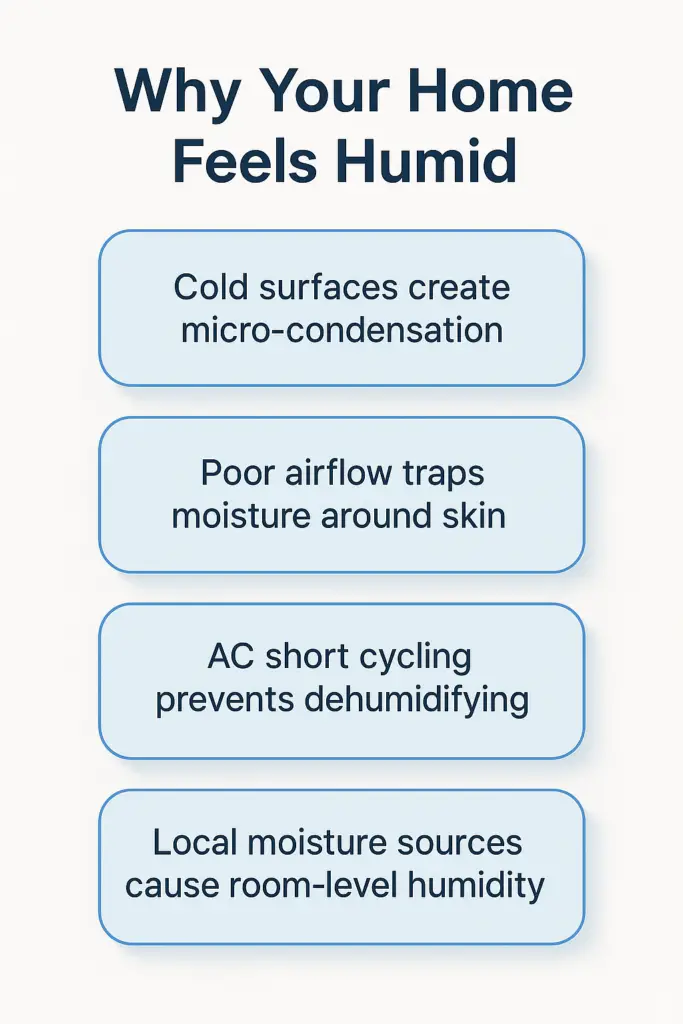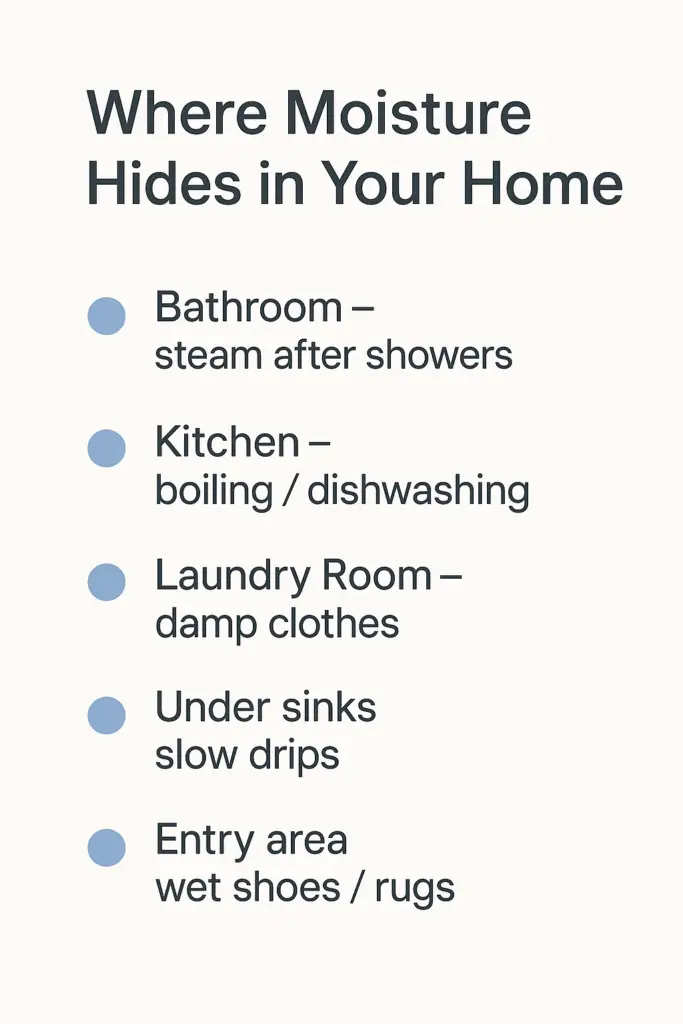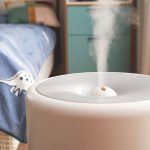Table of Contents
House Feels Humid But Humidity Is Not High
It’s confusing when your home feels sticky, clammy, or “muggy,” but your humidity monitor says everything is normal. You’re not imagining it — your home really can feel humid even when humidity isn’t high. This problem usually comes down to airflow, temperature balance, or hidden moisture sources that don’t show up on the hygrometer.
Let’s walk through why this happens, how to check for the root cause, and what quick fixes make your home feel dry again.
Why Your Home Can Feel Humid Even With Normal Humidity
The number on your humidity monitor doesn’t tell the whole story. Comfort also depends on surface temperatures, ventilation, and how long your AC runs.
Mini-case example: A reader wrote saying their living room felt sticky all evening even though their Govee hygrometer showed 44%. The issue wasn’t humidity — their AC was shutting off too quickly to remove moisture.

1. Cold Surfaces Cause a Damp Sensation
When floors, windows, or walls stay cooler than the surrounding air, tiny amounts of condensation form. You may not see it, but your skin feels it as humidity.
- Cold tile floors
- Shaded or north-facing rooms
- Poorly insulated exterior walls
2. Poor Airflow Makes the Air Feel Heavy
Even with perfect humidity, stagnant air traps moisture around your skin. Closed doors, blocked vents, and low HVAC airflow all add to the problem.
Running ceiling fans or temporarily switching your HVAC fan to ON helps break up the heavy feeling.
3. AC Cooling the Home Too Quickly
Your air conditioner removes moisture the longer it runs. If it cools too fast, it shuts off before it can dry the air. A smart thermostat such as a Honeywell Home thermostat can help extend runtime and improve whole-home comfort.
4. Small Moisture Sources in One Room
One room might feel humid even if the house does not. Small moisture sources can affect local comfort without raising whole-home humidity.
- Showering without ventilation
- Boiling water or dishwashing
- Indoor drying racks
- Slow plumbing drips under sinks

Quick Fixes That Usually Work Fast
Most people solve the “humid feeling” with one or two simple changes.
Increase Air Circulation
Use a ceiling fan, open interior doors, or run a small circulator. Even a compact table fan removes the heavy feeling quickly.
Give Your AC More Runtime
If your AC is short cycling, letting it run longer dries the air better. Smart thermostats — including options from Honeywell Home — help manage this automatically.
Ventilate High-Moisture Areas
Bathroom fans, kitchen range hoods, and even opening a window for a few minutes can prevent humidity from collecting in one room.
Check for Damp Items
A wet bathmat, towel, spilled water, or a slow drip can make a room feel humid without affecting the whole house.

Helpful Products That Actually Fix This
These simple tools make diagnosing and fixing the problem easier. Links below go to examples on Amazon.
1. A More Accurate Hygrometer
Reliable sensors from brands like Govee, ThermoPro, and AcuRite help you confirm what’s really happening.
Example: Govee digital hygrometer on Amazon
2. Small Room Dehumidifier
If just one room feels damp, a compact unit from Black+Decker, hOmeLabs, or Frigidaire dries it quickly.
Example: Black+Decker small-room dehumidifier
3. Smart Thermostat
Smart thermostats like Honeywell Home, Nest, and Ecobee help prevent short cycling so your AC actually removes moisture.
Example: Honeywell Home smart thermostat
Wrap-up: A humid-feeling home doesn’t always mean high humidity. Most of the time, the cause is airflow, cold surfaces, or short AC cycles. With a few simple adjustments — and maybe a useful tool or two — your home can feel dry and comfortable again.





